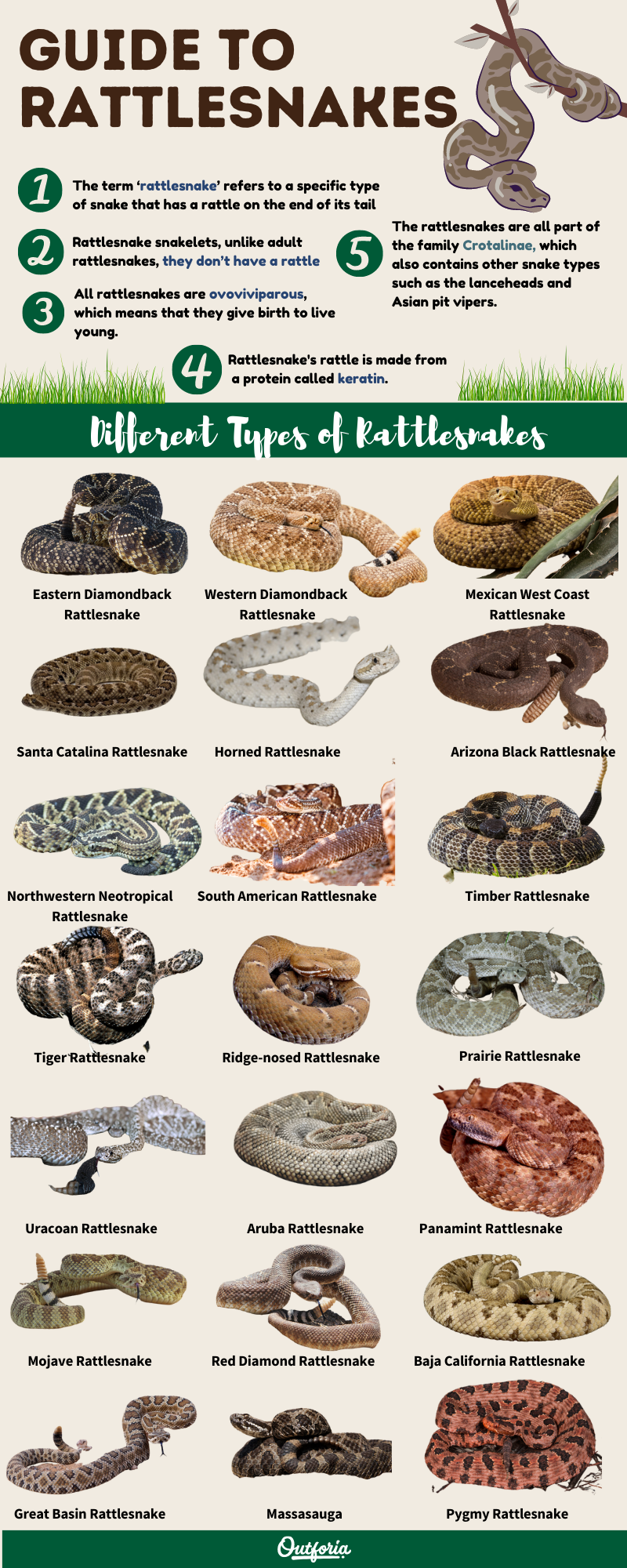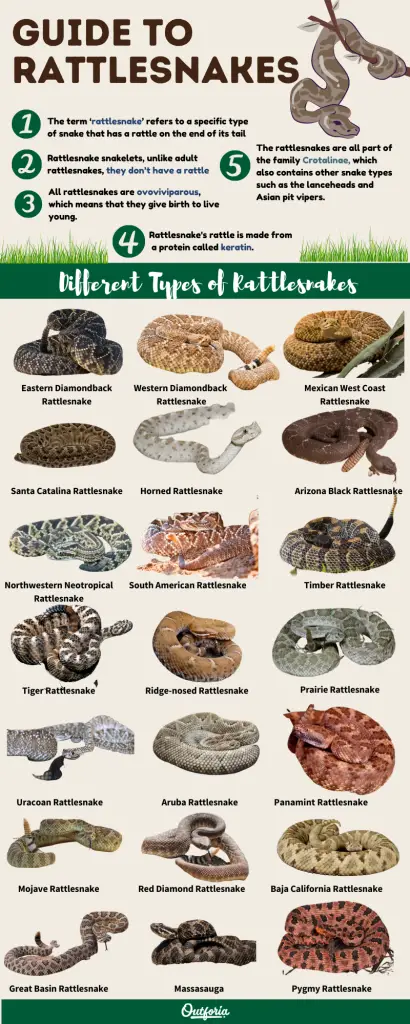Rattlesnakes are some of the most infamous and feared creatures in North America. Known for their distinctive warning rattle and venomous bite, these snakes have captured the attention of researchers and enthusiasts for decades. But just how many types of rattlesnakes are there? The answer may surprise you.
With over 30 different species of rattlesnakes found across the United States, identifying and understanding these snakes can be a daunting task. From the iconic Western Diamondback to the elusive Timber Rattlesnake, each species has its own unique characteristics and habitat preferences. Join us as we explore the fascinating world of rattlesnakes and uncover the secrets of these remarkable creatures.
There are approximately 36 species of rattlesnakes. They are found in North, Central, and South America. Each species has unique characteristics and venom types. Some common types include the Western Diamondback, Eastern Diamondback, Timber, and Sidewinder.

Types of Rattlesnakes: A Comprehensive Guide
Rattlesnakes are venomous reptiles that are found in North and South America. There are many different types of rattlesnakes, each with their own unique characteristics. In this article, we will explore the different types of rattlesnakes and what makes them distinct.
Eastern Diamondback Rattlesnake
The Eastern Diamondback Rattlesnake is the largest venomous snake in North America, with some individuals reaching lengths of up to eight feet. They are found in the southeastern United States, from North Carolina to Florida. The Eastern Diamondback Rattlesnake has a diamond-shaped pattern on its back and a thick rattle at the end of its tail. They are known for their powerful venom and aggressive behavior when threatened.
There are several benefits to having Eastern Diamondback Rattlesnakes in their natural habitat. They play a vital role in controlling rodent populations, which can carry diseases that are harmful to humans. However, when they come into contact with humans, they can be dangerous and should be avoided.
Western Diamondback Rattlesnake
The Western Diamondback Rattlesnake is found in the southwestern United States and Mexico. They have a distinctive diamond-shaped pattern on their back and a rattle at the end of their tail. Western Diamondback Rattlesnakes can grow up to six feet in length and are known for their strong venom.
While Western Diamondback Rattlesnakes can be dangerous when encountered by humans, they are an important part of the ecosystem. They help control the populations of rodents and other small animals, which can have a positive impact on the environment.
Sidewinder Rattlesnake
The Sidewinder Rattlesnake is found in the deserts of the southwestern United States and northern Mexico. They have a unique way of moving, which involves moving sideways across the sand. They have horns above their eyes and a rattle at the end of their tail.
While Sidewinder Rattlesnakes are not as dangerous to humans as some other types of rattlesnakes, they can still be venomous and should be avoided. They are an important part of the desert ecosystem, where they help control rodent populations.
Mojave Rattlesnake
The Mojave Rattlesnake is found in the southwestern United States and northern Mexico. They have a distinctive pattern on their back that consists of dark diamond-shaped blotches on a lighter background. The Mojave Rattlesnake has a reputation for being one of the most venomous snakes in North America.
The venom of the Mojave Rattlesnake can cause severe symptoms, including muscle weakness and respiratory failure. However, antivenom is available and can be effective in treating bites.
Timber Rattlesnake
The Timber Rattlesnake is found in the eastern United States, from Minnesota to Florida. They have a distinctive pattern on their back that consists of dark bands on a lighter background. The Timber Rattlesnake is known for its potent venom and its ability to blend in with its surroundings.
While the Timber Rattlesnake can be dangerous when encountered by humans, they play an important role in controlling rodent populations. They are also an important part of the ecosystem, where they help maintain a balance between predators and prey.
Massasauga Rattlesnake
The Massasauga Rattlesnake is found in the central United States and Canada. They have a distinctive pattern on their back that consists of dark blotches on a lighter background. The Massasauga Rattlesnake is known for its potent venom and its ability to blend in with its surroundings.
While the Massasauga Rattlesnake can be dangerous when encountered by humans, they play an important role in controlling rodent populations. They are also an important part of the ecosystem, where they help maintain a balance between predators and prey.
Black-Tailed Rattlesnake
The Black-Tailed Rattlesnake is found in the western United States and Mexico. They have a distinctive pattern on their back that consists of dark bands on a lighter background. The Black-Tailed Rattlesnake is known for its potent venom and its ability to blend in with its surroundings.
While the Black-Tailed Rattlesnake can be dangerous when encountered by humans, they play an important role in controlling rodent populations. They are also an important part of the ecosystem, where they help maintain a balance between predators and prey.
Speckled Rattlesnake
The Speckled Rattlesnake is found in the southwestern United States and northern Mexico. They have a distinctive pattern on their back that consists of light spots on a darker background. The Speckled Rattlesnake is known for its potent venom and its ability to blend in with its surroundings.
While the Speckled Rattlesnake can be dangerous when encountered by humans, they play an important role in controlling rodent populations. They are also an important part of the ecosystem, where they help maintain a balance between predators and prey.
Rock Rattlesnake
The Rock Rattlesnake is found in the southwestern United States and northern Mexico. They have a distinctive pattern on their back that consists of dark bands on a lighter background. The Rock Rattlesnake is known for its potent venom and its ability to blend in with its surroundings.
While the Rock Rattlesnake can be dangerous when encountered by humans, they play an important role in controlling rodent populations. They are also an important part of the ecosystem, where they help maintain a balance between predators and prey.
Green Rattlesnake
The Green Rattlesnake is found in the southwestern United States and northern Mexico. They have a distinctive green color that helps them blend in with their surroundings. The Green Rattlesnake is known for its potent venom and its ability to blend in with its surroundings.
While the Green Rattlesnake can be dangerous when encountered by humans, they play an important role in controlling rodent populations. They are also an important part of the ecosystem, where they help maintain a balance between predators and prey.
Conclusion
In conclusion, there are many different types of rattlesnakes, each with their own unique characteristics. While these snakes can be dangerous when encountered by humans, they play an important role in maintaining the balance of the ecosystem. By understanding the different types of rattlesnakes and their behaviors, we can learn to coexist with these fascinating creatures.
Frequently Asked Questions
Here are some common questions about rattlesnakes and their types:
What are rattlesnakes?
Rattlesnakes are venomous snakes that belong to the family Viperidae. They are known for their distinct rattle at the end of their tail, which they use as a warning signal when threatened. Rattlesnakes are found in various habitats, including deserts, forests, and grasslands.
There are about 36 known species of rattlesnakes, and they are native to the Americas. They vary in size, color, and behavior, but all have the characteristic rattle on their tail.
How do rattlesnakes use their venom?
Rattlesnakes use their venom to immobilize and kill their prey. Their venom is a complex mixture of enzymes and toxins that can cause tissue damage, blood clotting, and paralysis in their prey. It also helps them digest their food by breaking down proteins.
While rattlesnake venom can be dangerous to humans, not all species have venom that is lethal to humans. Most rattlesnake bites occur when humans accidentally step on or disturb a snake, and the snake bites in self-defense.
What are some common types of rattlesnakes?
Some of the most common types of rattlesnakes in the United States include the Eastern diamondback rattlesnake, the Western diamondback rattlesnake, the timber rattlesnake, and the prairie rattlesnake. These species are found in different regions and have distinct characteristics, but all have the characteristic rattle on their tail.
Other species of rattlesnakes include the sidewinder rattlesnake, the Mojave rattlesnake, and the coral snake. These species are also found in different regions and have unique adaptations that help them survive in their environments.
Where do rattlesnakes live?
Rattlesnakes are found throughout the Americas, from Canada to Argentina. They inhabit a range of habitats, including deserts, forests, grasslands, and swamps. In the United States, rattlesnakes are found in every state except for Alaska and Hawaii.
Rattlesnakes are cold-blooded and are more active during the warmer months of the year. They may hibernate during the winter in colder regions, but in warmer regions, they may be active year-round.
What should I do if I encounter a rattlesnake?
If you encounter a rattlesnake, stay calm and give the snake plenty of space. Do not approach or provoke the snake, as this can increase the likelihood of a bite. If you are hiking or walking in an area where rattlesnakes are known to live, wear sturdy boots and long pants to protect yourself.
If you are bitten by a rattlesnake, seek medical attention immediately. Do not attempt to suck out the venom or use a tourniquet, as these methods can cause more harm than good. Most hospitals carry antivenom for rattlesnake bites, which can help neutralize the effects of the venom.
All Rattlesnake species / types of Rattlesnake / rattle snake
In conclusion, there are numerous species of rattlesnakes that exist throughout the world. Depending on the source, the number of different types can vary. However, it is generally agreed that there are between 30 to 40 different species of rattlesnakes. These snakes can be found in a variety of habitats and have unique characteristics and behaviors.
While some may view rattlesnakes as dangerous and threatening, they play an important role in maintaining the balance of their ecosystems. They are skilled predators that help to control rodent populations, and their venom has even been used for medical purposes.
Overall, learning about the different types of rattlesnakes can be fascinating and informative. It can also help individuals to better understand and appreciate these creatures and the important role they play in our world. So, the next time you come across a rattlesnake, instead of feeling fear, take a moment to appreciate its beauty and uniqueness.


